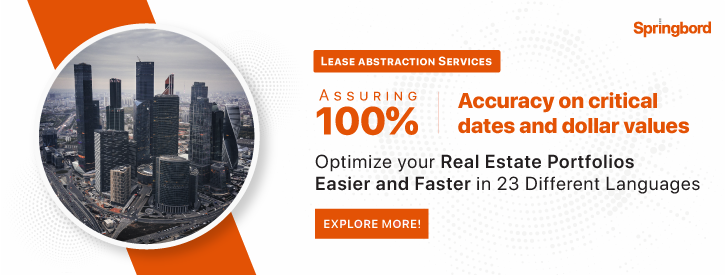 Read time 5 min
Read time 5 minAs a property owner or manager, you know that keeping track of all the costs associated with your property can be a daunting task. From rent payments to utility bills, it can be difficult to keep everything organized and ensure that all expenses are accounted for. That’s where a CAM Reconciliation Statement comes in.
A CAM (Common Area Maintenance) Reconciliation Statement is a document that details all of the costs associated with maintaining a property, including rent payments, utility bills, and any other expenses that are incurred during the course of a year. This statement is typically prepared by a property management company or a CAM Reconciliation service provider, such as Springbord.
In this blog, we will explain what a CAM Reconciliation Statement is, how it is used, and what information it contains. We will also discuss how we can help you understand and manage your CAM expenses more effectively.
In this blog, we will explain what a CAM Reconciliation Statement is, how it is used, and what information it contains, while also helping you understand and manage your CAM expenses more effectively. Additionally, we will discuss how outsourcing your CAM reconciliation service to experts can further streamline the process and ensure greater efficiency in managing your CAM expenses.
Tenant Information
A CAM Reconciliation Statement typically includes information about each tenant in the property, including their name, address, and contact information. This information is used to identify which tenants are responsible for paying their share of the property’s expenses.
In addition to tenant information, the statement will also include details about the property itself, such as the address, square footage, and number of units. This information is used to determine the overall cost of maintaining the property and to allocate expenses among the tenants.
Annual Property Expenses
The CAM Reconciliation Statement will also include a detailed breakdown of all the expenses associated with the property for the year in question. These expenses may include rent payments, utility bills, insurance, property taxes, and any other costs that are incurred during the course of the year.
These expenses are typically broken down into categories, such as operating expenses, capital expenses, and reserves. This allows property owners and managers to see exactly where their money is going and to identify any areas where costs can be reduced.
Tenant Dues/Escrow
One of the most important aspects of a CAM Reconciliation Statement is the section that details the tenant’s share of the property’s expenses. This section will include information about how much each tenant is responsible for paying, as well as any escrow or reserve funds that are being held in case of future expenses.
Tenant dues and escrow funds are typically calculated based on a formula that takes into account the tenant’s square footage, the number of units in the property, and any other relevant factors. These calculations are typically performed by a CAM Reconciliation service provider such as Springbord, who can ensure that the calculations are accurate and fair.
Deductions
In the context of CAM (Common Area Maintenance) reconciliation, deductions refer to the amount of money that is taken out of a tenant’s rent or lease payments to cover the expenses associated with maintaining the common areas of a commercial property. These expenses can include things like landscaping, janitorial services, and utilities for common areas.
When a tenant signs a lease for a commercial property, they typically agree to pay a certain amount of money each month to cover these expenses. This amount is typically calculated as a percentage of the tenant’s rent or lease payments. For example, a tenant might agree to pay 5% of their rent or lease payments towards CAM expenses.
Once the tenant starts paying this amount, the property manager or landlord will use the money to pay for the expenses associated with maintaining the common areas. If there is any money left over at the end of the month, it will be put into an escrow account.
Escrow
An escrow account is a type of account that is set up to hold money that is collected from tenants for CAM expenses. The money in this account is typically used to pay for the expenses associated with maintaining the common areas of a commercial property.
The escrow account is typically managed by a third party, such as a property management company or a bank. This is done to ensure that the money is used for its intended purpose and to prevent any conflicts of interest.
When the property manager or landlord needs to pay for expenses associated with maintaining the common areas, they will typically withdraw money from the escrow account. If there is not enough money in the account to cover the expenses, the property manager or landlord will typically ask the tenants to pay more money towards CAM expenses.
Balance
The balance of a CAM reconciliation statement refers to the difference between the amount of money that has been collected from tenants for CAM expenses and the amount of money that has been spent on maintaining the common areas.
If the balance is positive, it means that there is more money in the escrow account than has been spent on expenses. This money will typically be carried over to the next month and used to pay for future expenses.
If the balance is negative, it means that there is not enough money in the escrow account to cover all of the expenses associated with maintaining the common areas. In this case, the property manager or landlord will typically ask the tenants to pay more money towards CAM expenses.
Tenant Share
The tenant share of a CAM reconciliation statement refers to the amount of money that each tenant is responsible for paying towards CAM expenses. This amount is typically calculated as a percentage of the tenant’s rent or lease payments.
For example, a tenant might agree to pay 5% of their rent or lease payments towards CAM expenses. This means that if the tenant’s rent or lease payments are $1,000 per month, they would be responsible for paying $50 towards CAM expenses.
The tenant share is typically calculated and billed every month. This means that the tenant will receive a bill each month for their share of CAM expenses. If the tenant does not pay their share, the property manager or landlord may take legal action to collect the money.
Conclusion
As a property owner or manager, it is important to have a clear understanding of all the costs associated with your property. A CAM Reconciliation Statement is an essential tool for keeping track of these costs and ensuring that they are allocated fairly among tenants.
At Springbord, we understand the importance of accurate and transparent CAM Reconciliation Statements. Our team of experts can help you understand your property’s expenses, identify areas where costs can be reduced, and ensure that all tenant dues and escrow funds are calculated correctly. Contact us today to learn more about how we can help you manage your property expenses more effectively.







